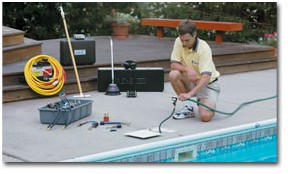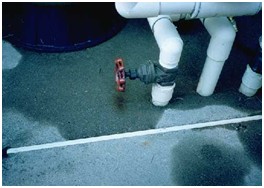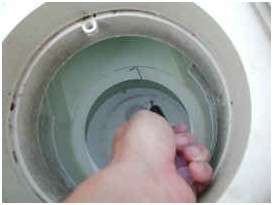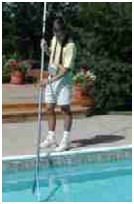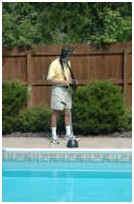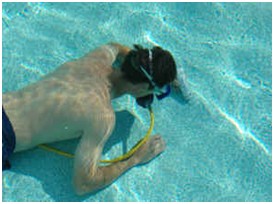How do I know if my swimming pool is leaking?It’s hard to keep water in a pool. Every swimming pool, spa or landscape pond is probably going to start leaking at some point in its useful life. These pesky problems can be more than just an inconvenience. An unrepaired hole the size of a pencil tip can result in hundreds of litres of water lost per day. In addition to the replacement cost of the water, leaks in your pool will increase chemical demands, and may lead to more serious structural and mechanical problems. Fortunately, effective leak location and leak repair solutions are available.
By far the most common indication of a leak is that the water level is dropping faster than what is normally attributable to evaporation or splash-out. Often leaks are big enough that excess water loss is obvious. If you wake-up to find that your pool has dropped several inches overnight you know you’ve got a problem. The bigger challenges are the smaller, yet just as serious leaks that may develop slowly. In these cases it is important to determine what 'normal water loss' is and thus avoid wasting time looking for and worrying about a leak that really isn’t there. A simple way to account for evaporation and confirm a leak is to do a Bucket test. If you have an automatic fill device on your pool a dropping water level may not be evident; high water bills may be the first indication of a leak problem. You may also notice an increase in the chemicals required to maintain proper balance, or that there is excess algae growth because the new water that’s being put into the pool is untreated. Other pool leak symptoms may be actual evidence of the water that has escaped from your pool. Wet, mushy or unusually 'healthy' spots in the lawn may be evidence of underground plumbing leaks. Structural damage cracks and settling to the deck or pool may also be indications of underground leaks. If left unrepaired these problems can quickly become more serious. Air in the pump or blown into the poolA pool leak in the suction side plumbing (from skimmers and main drains to equipment), may pull air into the plumbing lines that will show up in the pump or be blown back into the pool through the returns. Air leaks such as this can be just as damaging to your pool even though you may never notice symptoms of water loss. Evidence of air in the system can also be caused by a blockage or obstruction in the suction lines. Either situation will require professional attention to avoid causing mechanical damage to your pool equipment. Finding and fixing your leak is the next stepOnce you know you have a pool leak it’s time for action. The longer a leaking pipe, liner or pool shell is left unrepaired the more costly the eventual fix will be. You have options' some pool leaks can be easy to find and fix yourself. In most cases however a qualified and experienced pool leak professional using sophisticated electronic equipment will be able to provide more efficient and effective pool leak location and pool leak repair solutions that get you back into the water quickly. |
Can I find the swimming pool leak myself?
When done effectively the endeavour of locating a swimming pool leak follows a systematic procedure that progresses from the clear identification of leak symptoms to the exact location of the crack, hole or tear. While pool leak detection experts have the experience and equipment that allows this process to be performed in several hours or less, a diligent pool owner may be able to find some leaks themselves, or at least start the process that can make the leak professional’s job more efficient. Ask questions first . . . look for leaks laterWhen did the pool first start leaking? Were there any notable events that happened around this time? Recent construction activity around the pool, a pet or object that fell into the pool, or extremely cold, rainy or dry weather can all be events that may cause specific types of pool leaks. Does the water stop leaking at a certain level in the pool? Does the pool leak more with the pump running or with the pump off? Answers to these questions can provide an indication of where the pool leak is. More leakage when the pump is running usually indicates a pressure side plumbing leak, more water loss when the pump is off is usually indicative of a suction side plumbing leak, and equal water loss usually indicates a shell or pool liner leak. If you end up using a pool leak professional they also find the answers to these questions valuable in locating your swimming pool leak problem. They may also know when the pool was built; what type of pool it is, (vinyl liner, concrete, fibreglass, pool/spa combo), and if any repairs have been made recently. Be ready to share this information if you call. Searching for pool leaks
If you do decide to start looking for the problem yourself, the first step is to eliminate obvious and visible leaks. Check around the equipment for evidence of leakage or moisture. Carefully check all fittings that go into or out of the pool pump, filter or heater. Check for leaky pump lids, leaky valves or leaky seals. Also check to make sure that your multi-port valve is not leaking water to the waste line. If it’s possible to see where this backwash line empties, check to make sure that you don’t see water flowing or dripping from here.
Underwater leaks in the pool shell or fittings can be identified with a dye test. A Dye Tester allows placement of a small amount of colorant near (within 5mm) a suspected leak. Dye will be drawn out of the pool where there is a leak. Start by testing suspect areas such as cracks in the tile or plaster, inside the skimmer, and places where return fittings, skimmers or stairs join to the pool shell or liner. Many pool cracks may be just superficial and not be a cause for concern. If a crack is leaking however and draws dye it should be patched or professionally repaired. Most dye testing can be done from the pool deck, however you will eventually have to get into the pool with a dive mask to completely inspect the shell or liner for leaks. There are an assortment of epoxies and sealants that can be used by the do-it-yourselfer to fix a leak once found. Don't be discouraged if you can't find anything though; most pool leaks are not visibly obvious, or may be in parts of the pool, (such as the underground plumbing system or lights) that are inaccessible. A qualified seek-a-leak pool leak professional utilizing specialized equipment should be able to find a leak anywhere in your pool within an hour or two (some complicated jobs may take longer). |
How will a pool leak professional find my swimming pool leak?Your Seek-a-Leak swimming pool leak detection expert will follow a systematic approach when locating your pool leak. The process involves collecting and analysing a great deal of information. Knowledge of swimming pool operation and construction, use of specialized equipment, and on the job experience will all come into play as they locate leaks in your pool. The first step for any pool leak detection job happens before the pool leak professional ever gets to your pool. You should be prepared to provide information about your pool or spa to the technician over the phone when you first call. When did you first notice the leak problems? How much water is the pool losing (based on the results of a (bucket test)? How old is the pool? What type of pool is it? The more information you can provide about the suspected pool leak the better. Based on this information, your technician should be able to give you an idea of what type of detection or repair will be required and schedule the job. Keep in mind that due to the nature of leak detection work this scheduled time may be somewhat flexible. Pool leaks are a seasonal problem in most parts of the country and those who are good at finding leaks are usually very busy. Leak detection experts generally charge by the job or by the hour. Because of the specialized equipment and expertise required for leak work you should be prepared to pay a little bit more per hour for leak detection services than you would for most regular pool service activities. Once a technician is at your pool, the first step usually involves a pressure test of your plumbing lines to confirm whether the leak is in the plumbing or the shell of the pool. This testing will be done with specialized test plugs and pressure induction systems that are designed to give quick results. Based on the results of the pressure test, the technician will then use a variety of tests involving sophisticated electronics or diving equipment to pinpoint the pool leak.
Once the leaks are found most simple repairs (such as one or two vinyl patches) can be made immediately. Further repairs to cracks, underground plumbing, or pool equipment however, will usually involve additional work and tools and will be quoted separately. Some pool leak experts will be prepared to do these repairs themselves, others will refer you to repair or renovation specialists depending on the type of leak problem found. |
How do I prepare my swimming pool for the seek-a-leak technician?Your swimming pool needs to be full (so the equipment can operate) and clean and in a swimable condition. |

